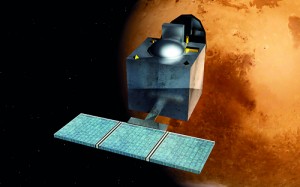Sunday Times 2
India’s Martian chronicles: space conquest and realities on the ground
NEW DELHI – The news that the Mars orbiter spacecraft Mangalyaan, launched by India on November 5, has left the Earth’s orbit, traversed the moon, and is on course for its ultimate destination, 400 million kilometers (249 million miles) away, brought early holiday cheer to Indians. Space missions have become a matter of pride for India, which is already one of the top countries in terms of rocket and satellite technology.

Artist's rendering of Mangalyaan orbiting Mars. Pic courtesy Wikimediacommons
Mangalyaan, India’s first inter-planetary satellite, was purpose-built for the Mars mission – and it was made entirely indigenously.Indian-educated scientists designed and fabricated it in barely 15 months – astonishingly fast for a country of chronic delays, where “Indian Standard Time” is a common joke. They also did so at a remarkably low cost, with the total bill coming in at under $73 million, or about a fifth of what the few other countries that have sought to explore Mars have spent. Indeed, while Indians often lament their country’s dysfunction, inadequate infrastructure, antiquated industrial processes, and uneven manufacturing record, it rose to the challenge and delivered.
But it is too early to celebrate. Five years ago, India’s lunar mission, called Chandrayaan, was the occasion for another national celebration. Though it was intended to explore the moon for two years, the spacecraft was declared lost after 312 days. While scientists at the Indian Space Research Organisation (ISRO) believe that they gained valuable lessons from the experience, the partial failure of the Chandrayaan mission still haunts them.
Moreover, the challenge is even greater when it comes to Mars. It is a sobering fact that of a total of 51 Mars missions sent out by five countries, 30 ended badly. Among India’s Asian rivals, neither Japan, which launched a Mars orbiter in 2003, nor China, which followed suit in 2011, was able to complete its mission successfully.
India hopes to join the three space programmes that have succeeded – those of the Soviet Union, the United States, and the European Union. Mangalyaan’s objective is to reach Mars’s orbit by September 2014 and to look for the presence of methane gas, a sign of possible life. Success would mark a scientific advance for humanity; failure, Indian scientists aver, would still provide a learning experience.
The ISRO’s chief scientist, K. Radhakrishnan, is not interested in comparisons with other countries: “We are in competition with ourselves,” he declared, “in the areas we have charted for ourselves.” India is increasingly regarded around the world as the leading developing country in the field, with the human-resource capacity and technological skills needed to work on the cutting edge of outer-space challenges.
India’s adventures in space exploration are not merely about its scientists’ ambitions. At United Nations forums, India has consistently been a voice for international cooperation in outer space. It speaks of being able to offer other countries, particularly from the developing world, an opportunity to participate in space exploration. Its moon mission in 2008, which carried a payload for some 20 countries, won the International Lunar Exploration Working Group’s International Cooperation Award.
Yet, unavoidably, some triumphalism has crept into the narrative. One of India’s more astute young commentators, Sreeram Chaulia, captures this heady exuberance well: “Every milestone in advanced rocket science,” he writes, “is a shot in the arm for national self-confidence, showing that India is headed for global leadership. When the chips are down, or if there is a national calamity, memories of the Mars orbiter blazing a trail in the sky will sustain the faith that the future belongs to India.”
This is precisely the attitude that raises the hackles of domestic critics, especially on the left, who argue that a country facing India’s crippling social and economic problems cannot afford the luxury of indulging in space exploration. Critics have portrayed the Mars mission as an irresponsible ego trip by pampered scientists disconnected from the harsh realities of Indian poverty and suffering.
This may not be entirely fair, however. India embarked on its quest for rocket and satellite technology and space exploration when it was far poorer, impelled by its own ancient scientific tradition and the conviction of its first prime minister, Jawaharlal Nehru, that such aspirations could co-exist with a determined effort to end poverty.
Indeed, India’s space scientists have produced tangible benefits for ordinary citizens, launching meteorological satellites that have predicted cyclones and helped save thousands of lives, as well as telecommunications satellites that have knit a vast country together through shared networks. Mitigating natural disasters and enabling nationwide broadcasting can hardly be considered to be disconnected from India’s real priorities.
With a general election looming in the months ahead, the air is already thick with political recrimination. The Mars mission – if it succeeds – is one thing that can literally rise above it all.
Shashi Tharoor is India’s Minister of State for Human Resource Development. His most recent book is Pax Indica: India and the World of the 21st Century.
Copyright: Project Syndicate, 2013. Exclusive to the Sunday Times
www.project-syndicate.org

